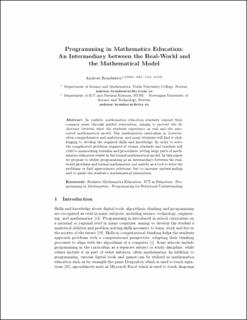| dc.description.abstract | In realistic mathematics education students expand their common sense through guided reinvention, aiming to prevent the dichotomy between what the students experience as real and the associated mathematical model. The mathematics curriculum is, however, often comprehensive and ambitious, and many students will find it challenging to develop the required skills and knowledge. In order to solve the complicated problems required at exams, students and teachers will yield to memorizing formulas and procedures, letting large parts of mathematics education reside in the formal mathematical model. In this paper we propose to utilize programming as an intermediary between the real-world problems and formal mathematics, not merely as a tool to solve the problems or find approximate solutions, but to increase understanding and to guide the student’s mathematical reinvention. | |
